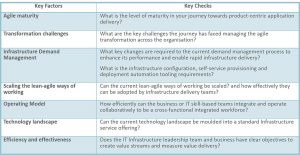Applying lean-agile approaches to Infrastructure Delivery Transformation
Share:
Date:
June 2020

key fact
2019 Gartner Research Circle survey on Agile in the Enterprise finds 46% of organisations use Agile for all or most of their Application Development. A further 43% use Agile for business support / operations and 85% Percent of organisations favour a Product-Centric Application Delivery Model.
Today’s businesses are continuously transformed by digital technologies and the rate of adopting lean-agile ways of working has increased rapidly, to ensure the fast-pace delivery of digital solutions. However, if organisations continue to manage the underlying IT infrastructure using traditional approaches, it will slow down this rapid revolution. Furthermore, to truly operate as an efficient, streamlined IT organisation, all its functions need to operate in harmony by adhering to a product-centric set of lean-agile principles, and ways of working.
Over recent years, many organisations have adopted lean-agile best practices and methodologies. As a result, the application delivery lifecycle has significantly shortened in order to meet the challenging demand on IT generated by today’s ‘go to market’ business strategy. To harness the full benefits of Digital Transformation it is essential for an IT Infrastructure function to align itself with these lean-agile ways of working.
Increasingly, waterfall and stage gated methods of IT infrastructure delivery are proving to be the key bottlenecks and pain points that can slow down the delivery of an organisation’s products and services, thus negating the efficiency gains achieved through the continuous integration (CI) and continuous delivery (CD) objectives of agile IT portfolio management.
Traditionally, the key focus for Infrastructure management has been the provision of a highly resilient and scalable infrastructure that delivers high availability and minimal downtime to perform troubleshooting and maintenance activities. Much less focus has been given to how quickly the Infrastructure is designed, built and deployed.
Today’s transformation strategies for digital Infrastructure are more driven by speed, flexibility and agility. For infrastructure transformation, this means ensuring infrastructure is available as on-demand, with minimal design and configuration efforts and the ability to dispose or upgrade infrastructure services instantly. Looking at the current trends and modern developments within the infrastructure management space, the focus has shifted from traditional ways of designing and building IT infrastructure to software defined infrastructure and ‘Infrastructure as code’, that enable designing and building of IT infrastructure by developing a script or a configuration file that can be deployed, tested and further automated (to run in the background of an automated service request workflow).
Therefore, modernising traditional ways of designing, building and deploying infrastructure statically, needs to consider approaches that explore opportunities to transition infrastructure delivery towards software best practices in order to accelerate the pace at which digital products and services can be delivered.
Modernising Infrastructure Delivery
The top transformational levers that enable rapid infrastructure enablement need to consider following six lean-agile attributes for the infrastructure services strategy.
- Architecture that supports the agile Infrastructure Services Strategy
Starting with the ‘IT Strategy and Architecture function’, the key shift must focus on ensuring the current IT architecture and the future IT roadmap, supports the way infrastructure is envisioned, designed and deployed. The Enterprise Architecture function needs to support lean-agile development practices, define value-streams and promote collaboration between architects, development and delivery teams and to breakdown the culture of working in silos. Enterprise Architects need to be proactive in ensuring that the architectural runway is ready to be consumed ahead of product delivery sprints, and to minimise the excessive redesign and delays introduced by technical design authority reviews and information security requirements.
Organisations adopting the Product-Centric delivery model must ensure that their architectural runway simplifies the infrastructure design and demand management process to support the continuous flow of value through the Continuous Delivery Pipeline.[1] Maintaining simple architectural standards will create standard infrastructure service design patterns which can be reused based on the type of functional and non-functional business requirements they support.
- Agile Operating model for the digital infrastructure delivery
The operating model for an IT infrastructure organisation needs to align and form a strategic alliance between infrastructure and application teams that enable synchronised ways of working towards designing, building, configuring, testing and deploying Infrastructure and application services. Organisations on the product-centric application development journey need to consider integrating responsibilities between cross functional teams to ensure that infrastructure service offerings are aligned across all IT service offerings, and provide end to end infrastructure service delivery. They must also ensure that the agile operating model consists of a strong product ownership approach from Business and Product owners who work closely with business and IT at all stages of IT lifecycle.
- Strategic alliance between DevOps and InfraOps
The transformation focus needs to explore an integrated approach of strategically aligning the IT Infrastructure, Application Development and IT Operations functions into a single operating model that will encourage partnership and develop collaborative ways of working between the teams. In addition to adopting lean-agile ways of working, the next phase of transformation is to implement DevOps strategies to integrate the Infrastructure and Development functions. This allows them to be more effective in managing complexities and challenges arising from legacy and hybrid-cloud models. The strategic partnership and alliance between the cross-functional IT functions need to ensure that Infrastructure service configuration and deployment activities are led by centralised ‘Product-Centric’ application development teams autonomously and manage test and deployment activities in line with the iterative delivery plans.
- Enabling self-service for on-demand Infrastructure delivery
The infrastructure services strategy and roadmap to modernise infrastructure delivery needs to address a ‘standardised digital Infrastructure services’ offering that is available, on demand, in a self-service enabled service catalogue. The standardised infrastructure service catalogue needs to be accessible to technical architects, application developers and test managers. With the adoption of cloud based delivery, it has become critical to enable self-service management, configuration and automated deployment of infrastructure changes to digital service components. Enabling on-demand self-service to infrastructure delivery can potentially reduce the provisioning time from hours to minutes. However, the infrastructure delivery organisation needs to be wary that their provisioning process must have a supporting underlying business rationale, monitoring and control mechanism in place. This maintains transparency and control over unconstrained demand for infrastructure services, and ensures that the balance between capacity and demand is maintained.
- Managing changes in Infrastructure Service Delivery
To accelerate the rapid deployment of changes to infrastructure services delivery it is essential to make the necessary shift in how infrastructure changes are managed. Infrastructure services considering lean-agile approaches should implement ways of working to promote early and continuous engagement with the Change Management function throughout the infrastructure delivery lifecycle. Furthermore, transformation strategies need to consider simplifying change review and approval processes and decentralising change management function by providing guardrails to safely and swiftly manage change implementations activities [2]. Business agility transformation strategies need to support these guardrails by defining set of agreements that key roles make with each other when working together between the cross-functional teams.
IT departments should approach change implementation in an iterative way by enabling infrastructure delivery teams to develop, test and deploy changes in small iterations so changes are quickly enacted and controlled, and ensure that infrastructure change implementation is more closely aligned and driven by application development teams.
- Enabling’ Infrastructure as Code’ capabilities
Infrastructure design, configuration and deployment through seamless cloud enabled technologies has proved to be key to reducing delivery cycle times and maximising the flow of continuous integration and continuous delivery objectives.
Lean-agile infrastructure delivery should consider automating infrastructure configuration and deployment activities by adopting cloud-agnostic Infrastructure as Code tools that can configure, provision and deploy infrastructure services on-demand, therefore, accelerating IT Infrastructure delivery by unifying cross-functional teams to use common operating model enabled by software defined IT services.
Selecting the ‘fit for purpose’ transformation approach for an organisation’s Infrastructure Service Delivery will be based on several key factors:

By analysing the responses to these checks in the current environment, the agile transformation approach for infrastructure service delivery can be structured by appointing key agile change agents within the IT Architecture and Infrastructure organisation. These change agents, working closely with the application and infrastructure delivery teams, need to evolve the cross functional collaboration and lean-agile ways of working. In parallel, the current governance structures and senior management teams must adapt, to ensure that the lean-agile transformation objectives and goals are progressing in the right direction and improvement opportunities are continuously identified.
[1] Architectural Runway https://www.scaledagileframework.com/architectural-runway/
[2] Lean-Agile Leadership. https://www.scaledagileframework.com/lean-agile-leadership/
If you want to find out more about our services click here.
Author: Kaustubh Ambavanekar
Published: LinkedIn
Disclaimer – opinions expressed in the text belong solely to the author, and not necessarily to the author’s employer or organisation.